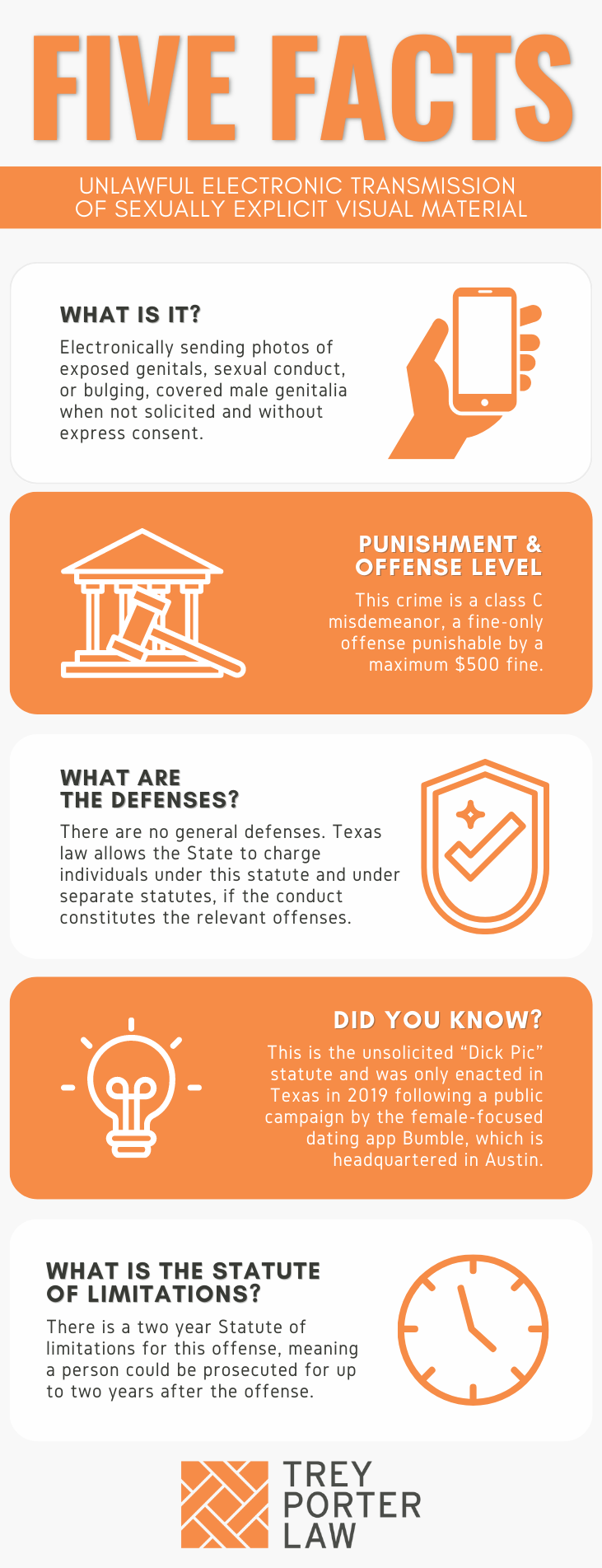WHAT IS UNLAWFUL ELECTRONIC TRANSMISSION OF SEXUALLY EXPLICIT VISUAL MATERIAL IN TEXAS?
The Texas law against unlawful electronic transmission of sexually explicit visual material prohibits texting or emailing sexually explicit photographs or videos to another without consent.

- What is sexually explicit visual material? Texas Penal Code Section 33.021 defines “sexually explicit” as “any communication, language, or material, including a photograph or video image, that relates to or describes sexual conduct.”Texas Penal Code Section 43.25 defines “Sexual conduct” as “sexual contact, actual or simulated sexual intercourse, deviate sexual intercourse, sexual bestiality, masturbation, sado-masochistic abuse, or lewd exhibition of the genitals, the anus, or any portion of the female breast below the top of the areola.”Sexually explicit visual material includes photographs, videos, or other visual reproduction or image showing a person’s genitals, pubic area, female nipple, anus, or buttocks, a male’s erect penis (even if covered by clothing), or at least one person engaging in sexual conduct.
WHAT IS THE UNLAWFUL ELECTRONIC TRANSMISSION OF SEXUALLY EXPLICIT VISUAL MATERIAL LAW IN TEXAS?
Tex. Penal Code § 21.19. UNLAWFUL ELECTRONIC TRANSMISSION OF SEXUALLY EXPLICIT VISUAL MATERIAL.
(b) A person commits an offense if the person knowingly transmits by electronic means visual material that:
(1) depicts:
(A) any person engaging in sexual conduct or with the person’s intimate parts exposed; or
(B) covered genitals of a male person that are in a discernibly turgid state; and
(2) is not sent at the request of or with the express consent of the recipient.
(c) An offense under this section is a Class C misdemeanor.
(d) If conduct that constitutes an offense under this section also constitutes an offense under any other law, the actor may be prosecuted under this section or the other law.
WHAT IS THE PENALTY CLASS FOR UNLAWFUL ELECTRONIC TRANSMISSION OF SEXUALLY EXPLICIT VISUAL MATERIAL IN TEXAS?
Unlawfully electronically transmitting sexually explicit visual material is a Class C misdemeanor, punishable by up to a $500 fine.
Pursuant to Texas Penal Code Section 12.501, if the offense is committed against a public servant, a member of the public servant’s family or household, in retaliation for or on account of the public servant’s status, the penalty classification is increased to a Class B misdemeanor, punishable by up to 180 days in jail.
WHAT IS THE PUNISHMENT RANGE FOR UNLAWFUL ELECTRONIC TRANSMISSION OF SEXUALLY EXPLICIT VISUAL MATERIAL IN TEXAS?
The punishment range for unlawful electronic transmission of sexually explicit visual material, a Class C misdemeanor, is a maximum fine of $500 and no jail time. If the offense was committed against a public servant and increased to a Class B misdemeanor, the punishment range is a maximum jail sentence of 180 days, and up to a $2,000 fine.
WHAT ARE THE PENALTIES FOR UNLAWFUL ELECTRONIC TRANSMISSION OF SEXUALLY EXPLICIT VISUAL MATERIAL IN TEXAS?
A person charged with Class C misdemeanor unlawful electronic transmission of sexually explicit material may avoid a conviction by pleading guilty or nolo contendere (“no contest”) to a judge in exchange for a grant of deferred adjudication. The period of deferred adjudication for a Class C misdemeanor may not exceed 180 days.
A person charged with Class B misdemeanor unlawful electronic transmission of sexually explicit visual material may be placed on probation after a conviction, or deferred adjudication without a conviction, for a period of up to two years.
WHAT ARE THE DEFENSES TO UNLAWFUL ELECTRONIC TRANSMISSION OF SEXUALLY EXPLICIT VISUAL MATERIAL IN TEXAS?
The statute does not authorize specific defenses to unlawful electronic transmission of sexually explicit visual material. A person accused thereof may assert any defense in an attempt to negate at least one of the elements the State must prove at trial.
- Does the Texas law against unlawful electronic transmission of sexually explicit visual material violate the First Amendment? The law against texting or emailing unwanted sexually explicit material directly regulates speech, so it is potentially unconstitutional. An accused may challenge the constitutionality of the statute as overbroad, and it will have to withstand a strict scrutiny analysis.
WHAT IS THE STATUTE OF LIMITATIONS FOR UNLAWFUL ELECTRONIC TRANSMISSION OF SEXUALLY EXPLICIT VISUAL MATERIAL IN TEXAS?
The limitation period for unlawful electronic transmission of sexually explicit visual material is two years.
UNLAWFUL ELECTRONIC TRANSMISSION OF SEXUALLY EXPLICIT VISUAL MATERIAL IN TEXAS
Texas law prohibits texting, emailing, or other electronic transmission of sexually explicit photographs and videos. Enacted in 2019, the constitutionality of this law’s restriction on speech and expression is still in question.
















